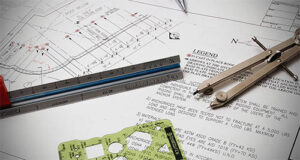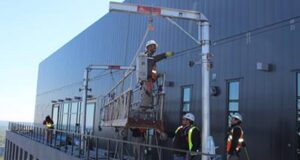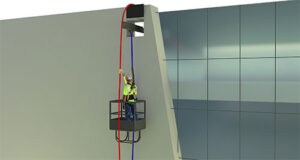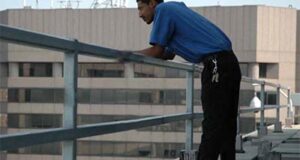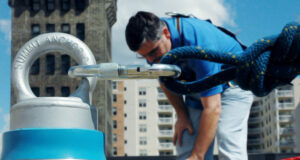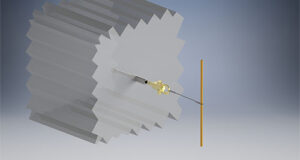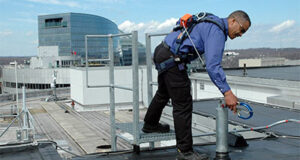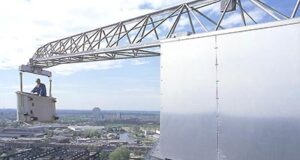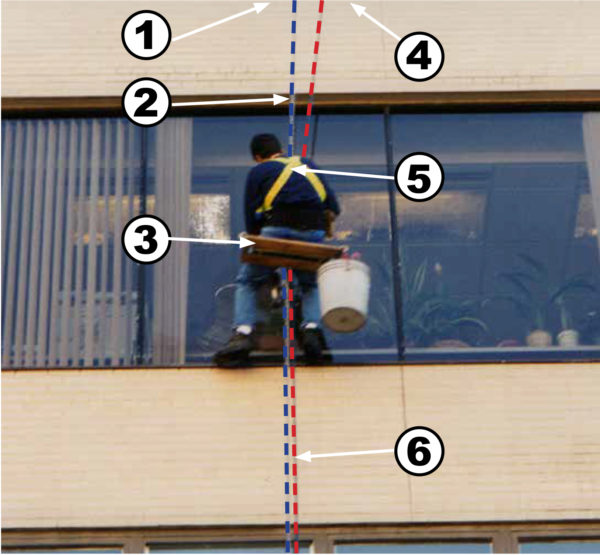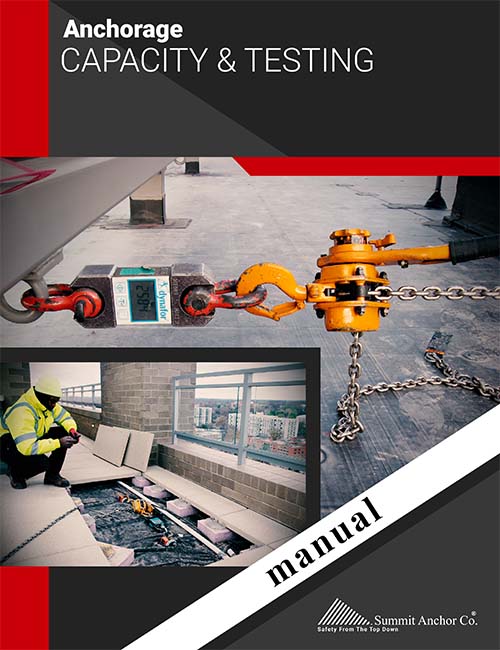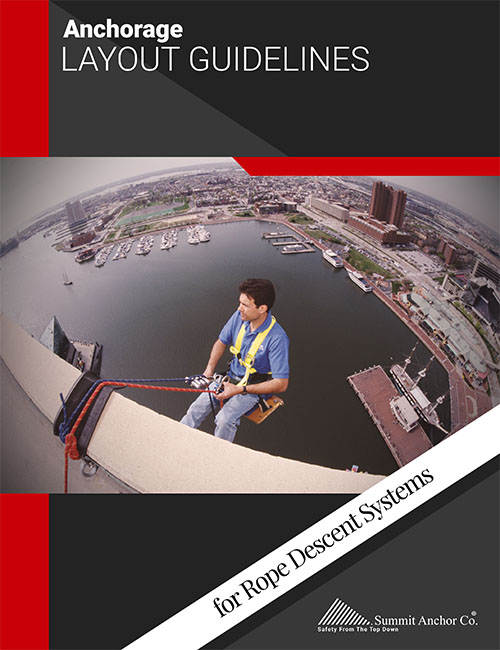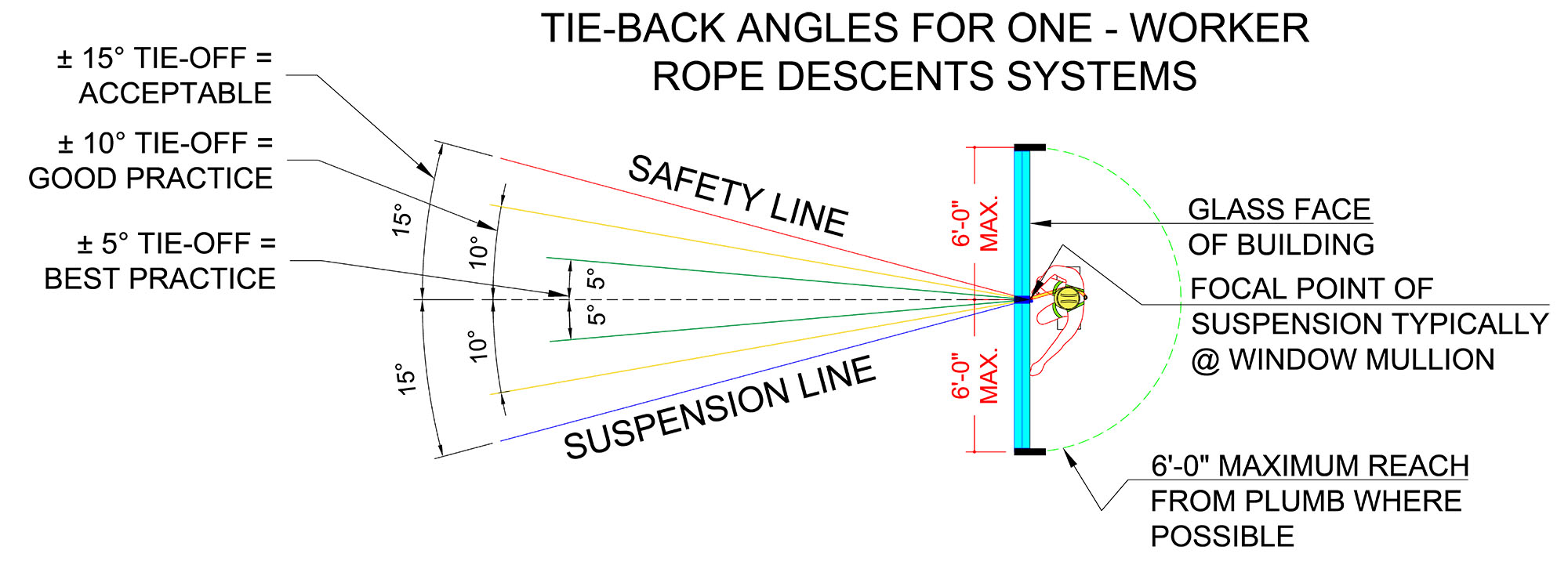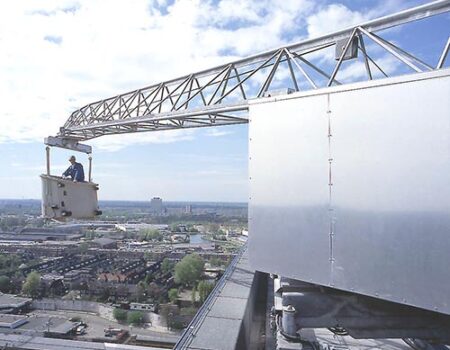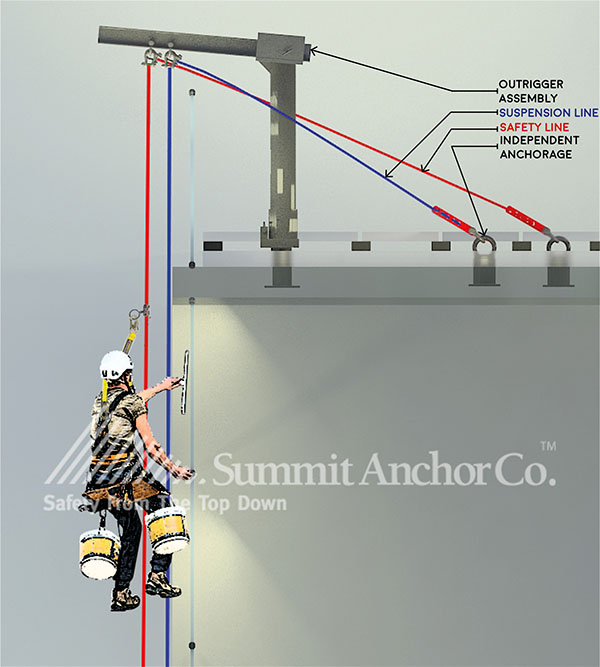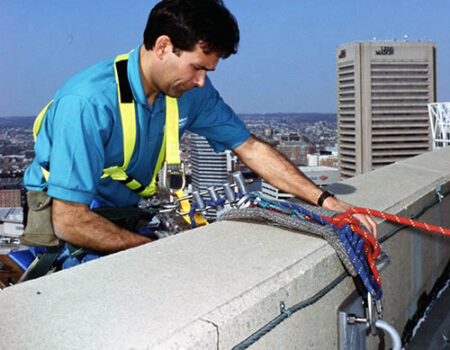Rope Descent System
What is a Rope Descent System (RDS) and how does it work?
A Rope Descent System is a non-motorized system that allows the workers to use gravity to control their rate of descent to access the interior and exterior façade of a building. The system’s friction device also allows workers to stop the descent and to remain suspended at any location along their rope to perform their work. By some estimates, 60 to 80 percent of all high-rise window cleaning operations in the United States use RDS.
Below are questions and answers to OSHA’s definition of an RDS, as defined in OSHA Subpart D. It is important that the designer understand OSHA’s use of these definitions to avoid confusion when designing an RDS.
What does a Rope Descent System consist of?
- “Rope descent system…usually consists of a roof anchorage, support rope, a descent device, carabiner(s) or shackle(s), and a chair (seatboard). A rope descent device does not include industrial rope access system.” (OSHA Subpart D. Section 1910.27 section (b)(l)(i))
- “Each employee uses a separate, independent personal fall arrest system that meets the requirements of subpart I of this part.” (OSHA Subpart D. Section 1910.27 section (b)(2)(vi))
- “Stabilization is provided at the specific work location when descents are greater than 130 feet (39.6 m)” (OSHA Subpart D. Section 1910.27 section (b)(l)(x))
What height limitations are there with a Rope Descent System?
OSHA restricts a rope descent to 300 feet, unless there isn’t another way to do the work or it poses a greater hazard by not performing a 300-foot rope descent. See OSHA’s 300-foot rule below:
“Use of rope descent systems. The employer must ensure: No rope descent system is used for heights greater than 300 feet (91 m) above grade unless the employer demonstrates that it is not feasible to access such heights by any other means or that those means pose a greater hazard than using a rope descent system…” (OSHA Subpart D. Section 1910.27 section (b)(2)(i))
Safety from the top down.
CLICK HERE to request a quote using our Design Assist Request.
What is the required load capacity for anchorages used for Rope Descent Systems?
OSHA requires each anchor to be capable of supporting at least 5,000 pounds. See OSHA’s requirements for anchor capacity for rope descent systems:
“Rope descent system–(1) Anchorages (I) Before any rope descent system is used, the building owner must inform the employer, in writing that the building owner has identified, tested, certified, and maintained each anchorage so it is capable of supporting at least 5,000 pounds, in any direction, for each employee attached. Anchorages used to attach to personal fall protection equipment must be independent…capable of supporting at least 5,000 pounds (22.2kN) for each employee attached…” (OSHA Subpart D. Section 1910.27 section (b)(l)(i))
Rope descent system components:
1. Rope attached to an independent Anchorage on the roof
2. Suspension Line (Blue)
3. Seat board
RDS requisite independent fall arrest system:
4. Rope attached to an independent Anchorage on the roof
5. Full body harness
6. Lifeline (Red)
Does OSHA provide layout guidelines for anchors for rope descent systems?
OSHA requires proper rigging of rope descent systems. Basically, this means that each worker is required to be attached to two independent anchorages. One anchor is for a lifeline and the other for the suspension line. Anchors located within 15 feet of the edge require workers to observe OSHA fall protection rules.
Below are OSHA’s requirements for anchors used in a rope descent system:
“Each employee used a separate, independent personal fall arrest system…” (OSHA 1910.27 Subpart D for Rope Descent Systems section (vi).
- “(12) Anchorages used to attach to personal fall protection equipment must be independent.
Safety from the top down.
CLICK HERE to request a quote using our Design Assist Request.
Anchor Layout Diagram, based on the I.14 Window Cleaning Safety Standard
What is the building owner’s responsibility to contractors who use rope descent systems?
The owner is responsible for providing written assurance that the anchorages meet OSHA’s 5,000 load requirement. Anchor testing is required to confirm the anchor’s capacity. See OSHA’s anchor loading requirements below:
“Before any rope descent system is used, the building owner must inform the employer, in writing that the building owner has identified, tested, certified, and maintained each anchorage so it is capable of supporting 5,000 pounds in any direction, for each employee attached…” (OSHA Subpart D. Section 1910.27 section (b)(l)(i)
What is the employer’s responsibility to workers using rope descent access?
The employer must not perform work unless the building owner provides written assurance that the anchorages have been tested and certified within the previous 10 years, are inspected annually, and meet OSHA requirements. See OSHA’s requirements for the employer below:
“The employer must ensure that no employee uses any anchorage before the employer has obtained written information from the building owner that each anchorage meets the requirements of OSHA Subpart D, (b)(l)(i) of this section.
What is the timeline for building owners to comply with OSHA’s rope descent system requirements?
“The requirements…must be implemented no later than November 20, 2017.” (OSHA Subpart D. Section 1910.27 section (b)(l)(iii)
What can owners do if their buildings aren’t in compliance?
Building owners can get proposals from reputable companies for testing existing equipment as well as for installing new anchor systems or replacing failed anchors. While installing anchors may be costly, the building owner should weigh the risk of not complying with OSHA requirements. See the OSHA memorandum to OSHA compliance officers:
https://www.osha.gov/laws-regs/standardinterpretations/2017-11-20
Is a counter weighted outrigger an acceptable substitute for permanently installed anchorages?
A counter weighted outrigger must have appropriate load capacity and must be tied back to an anchorage with a 5,000-pound load capacity. This is because a portable outrigger is a non-permanent anchorage requiring a tieback. Because the tieback is a component of the rope descent system it therefore requires an anchorage with a 5,000-pound load capacity. See OSHA’s requirement for non-permanent anchorages below:
“The rope descent system has proper rigging, including anchorages and tiebacks, with particular emphasis on providing tiebacks when counterweights, cornice hooks, or similar non-permanent anchorages are used…”(OSHA Subpart D. Section 1910.27 section (b)(l)(v))
“All components of each rope descent system, except the seat boards, are capable of sustaining a minimum rated load of 5,000 pounds (22.2 kN).” (OSHA Subpart D. Section 1910.27 section (b)(l)(vii))
Safety from the top down.
CLICK HERE to request a quote using our Design Assist Request.
Design & Layout
Experience and forethought is required to design a suspended maintenance system that is code-compliant and safe to utilize as well as install. OSHA Subpart D requires that “anchor design and layout shall be performed by a qualified person experienced in such design”. Summit Anchor Co. has years of experience designing code-compliant systems and providing layout drawings for use during installation, testing, and future maintenance work.
Design Considerations
- Carefully examine all pertinent structural and architectural projects drawings to find areas required suspended access:
- Windows located above 20 foot
- Building facade requiring periodic maintenance (i.e. re-caulking and waterproofing)
- Areas above 4 foot from grade that workers will need to access
- Identify unique building features that may require additional suspended maintenance products:
- Overhangs
- Atriums
- Sloped roofs
- Roofs above 300 ft.
- Cornice conditions
- Balconies
- Rotundas
- Sloped walls
- Curtain walls
- Canopies, signage, and other projections
- Determine if anchors will be used for rope descents systems, for fall protection for personnel on swing stage, general fall protection for horizontal lifelines or all of the above.
- Identify structural features to witch anchors may be attached:
- Roof slabs
- Concrete curbs
- Concrete beams
- Concrete walls
- Cornice conditions
- Steel beams
- Verify that structural features to witch anchors and davits, etc. might be attached have the capacity to support the allowable, test, and ultimate loading requirements below. OSHA and ANSI I-14.1 standards require that structural elements are capable of supporting loading requirements (see loading requirements).
- Verify that structural capacity of the parapet wall commensurate with the loading application (i.e. parapet clamps, outriggers, suspension lines, fall arrest lines, power cables, etc.) during suspended maintenance. If the parapet wall cannot support these loads, additional suspended maintenance products may be required to circumvent loading the parapet.
- Verify that workers will be able to safely access anchor locations. The ANSI/IWCA I-14.1 requires fall protections when a maintenance worker must travel within 6 feet of an unprotected edge.
“Rope descents shall not exceed 300 feet.” Therefore, buildings over 300 ft. are the best suited with permanently installed powered platform.
Davits are a solution If parapet or glass guardrail is not adequate to support loads from workers ropes.
Safety from the top down.
CLICK HERE to request a quote using our Design Assist Request.
Anchor Layout Requirements
- Anchors shall be identified on a plan of maintenance, typically posted on the inside of the roof door, so that workers can easily locate these anchorages on roofs.
- Each worker shall be tied off to two independent anchorages – one for a fall rope and one for a suspension rope.
- Anchorages shall be placed in line with the work area required service, and there shall be no objects obstructing the path of the rope from the anchorages to the work area. Properly aligned anchors prevent unsafe lateral rope movement or displacement, which damages the rope proportionate to load.
- Anchors should be placed to allow for at least two workers to make rope descending system descents in the same area of the building facade for both suspension line and fall arrest line.
- Consideration should be given to providing sufficient anchorage for rescue workers to access window cleaners in the event that they are stranded on the facade of the building. (Click here to see why this is so important.)
- Anchors shall not be placed within 6 feet (1800mm) of an unprotected roof edge unless fall protection is provided. In most cases anchors can and should be placed further then 6 feet (1800mm) back from the edge to reduce risk falling.
- Outside corners of the roof are of particular concern. Anchors must be located to prevent the rope from being displaced on the parapet/guardrail. See diagram below:

- The diagram below illustrates the standards governing a safe placement of roof anchors:
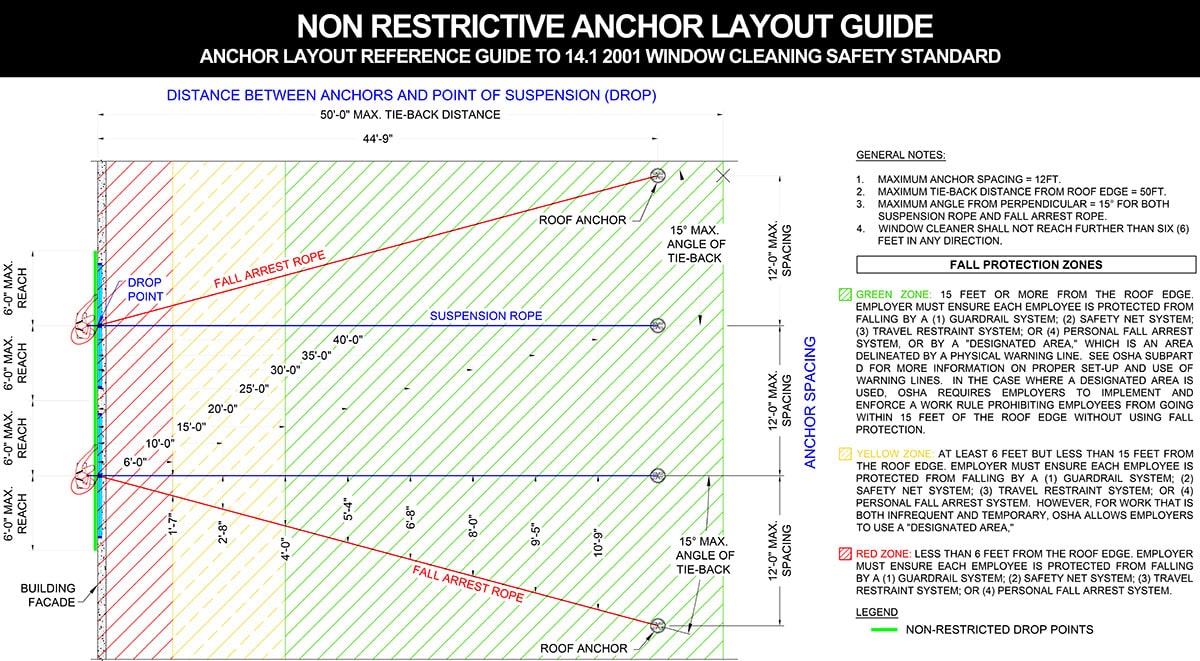
Safety from the top down.
CLICK HERE to request a quote using our Design Assist Request.
Contact Summit Anchor Co. for assistance with your suspended maintenance layout:
To help give you an idea of what may be required to accommodate your project’s suspended maintenance needs, Summit Anchor Co. offers design assistance (see our Design Assist Request). We will review your project’s needs, and based on our expert experience we will offer suggestions for the correct type of equipment needed and the general locations where these should be installed.
Please provide us with following information in the form of AutoCAD drawing files:
- Architectural and structural floor plans of any level where equipment is required
- Building elevations
- Section drawings of the parapet walls, penthouse walls, and roof
- Additional drawings showing relevant suspended maintenance of building facade

